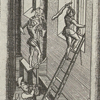Power, Faith, and Pictures: Frans Hogenberg’s Account of the Beeldenstorm
DOI:
https://doi.org/10.18352/bmgn-lchr.10182Keywords:
Iconoclastic Fury, Iconoclasm, History, Low Countries, BelgiumAbstract
Frans Hogenberg’s depiction of the Beeldenstorm is one of the most popular and influential visual accounts of iconoclasm. However, it has been considered controversial in Academia due to the account’s complex visual rhetoric. To tackle this complexity this contribution offers a close reading of Hogenberg’s depiction as an historical source by exploring its various references and allusions. The printed image allows historians to gain insights into the religious and political culture of the second half of the sixteenth century.
This essay argues that Hogenberg’s account of the Beeldenstorm is a reflection on the power of images and its limitations. As such, the print was directly involved in the battle of how to understand contemporary religious and political conflicts. Although the account appeals to a heterogeneous audience, it depicts the Beeldenstorm in neither a neutral nor in an objective way, but from a position of religious compromise and secular unanimity.
This article is part of the special issue 'Beeldenstorm' and was nominated for the Low Countries History Award in 2019 (for the best article in BMGN - Low Countries Historical Review over the years 2016-2017-2018).
Macht, geloof, en afbeeldingen. Frans Hogenbergs uitbeelding van de Beeldenstorm
Frans Hogenbergs uitbeelding van de Beeldenstorm is een van bekendste en invloedrijkste visuele weergaven van iconoclasme. Binnen het academisch onderzoek hebben echter verhitte discussies gewoed als gevolg van de gecompliceerde visuele retoriek in de afbeelding. Om deze complexiteit te ontrafelen hanteert dit artikel een nauwkeurige lezing van de afbeelding als historische bron en onderzoekt het de verschillende verwijzingen en zinspelingen er in. De afbeelding verschaft historici de mogelijkheid inzicht te krijgen in de religieuze en politieke cultuur van de tweede helft van de zestiende eeuw.
Het artikel stelt dat Hogenbergs weergave van de Beeldenstorm een reflectie is op de kracht van beelden en hun beperkingen. De gravure was als zodanig zelf onderdeel van de strijd over de vraag hoe de religieuze en politieke conflicten van die tijd moesten worden begrepen. Hoewel de afbeelding uiteenlopende toeschouwers wil aanspreken, geeft zij de Beeldenstorm niet op een neutrale of objectieve wijze weer, maar vanuit een stellingname voor een religieus compromis en seculiere eensgezindheid.
Dit artikel maakt deel uit van het themanummer 'Beeldenstorm' en werd genomineerd voor de Low Countries History Award in 2019 (voor het beste artikel in BMGN - Low Countries Historical Review in 2016-2017-2018).
Downloads

Published
Issue
Section
License
Authors who publish with this journal agree to the following terms:
a) Authors retain copyright and grant the journal right of first publication with the work simultaneously licensed under a Creative Commons Attribution 4.0 International (CC BY 4.0) that allows others to share the work with an acknowledgement of the work's authorship and initial publication in this journal.
b) Authors are able to enter into separate, additional contractual arrangements for the non-exclusive distribution of the journal's published version of the work (e.g., post it to an institutional repository or publish it in a book), with an acknowledgement of its initial publication in this journal.
c) Authors are permitted to post their work online (e.g., in institutional repositories or on their website) prior to and during the submission process.
Authors are explicitly encouraged to deposit their published article in their institutional repository.







